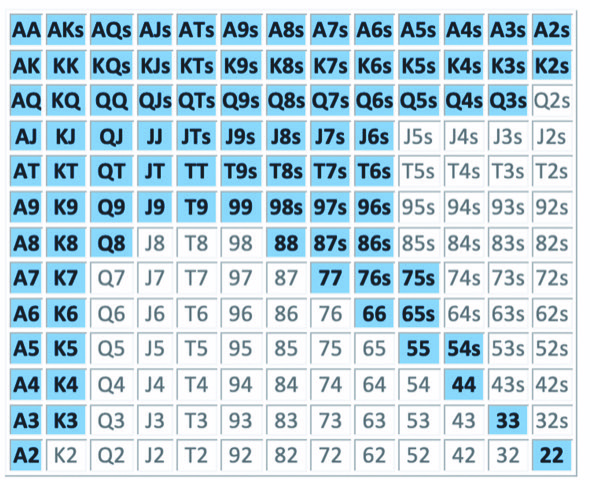






Returning To Live Poker After The Pandemic: Part 2by Steve Zolotow | Published: Aug 11, 2021 |
|
|
As I mentioned at the end of the first part of this series, I decided I would play three to five of the $10,000 buy-in events at the U.S. Poker Open in the PokerGO studio at Aria. I looked on this as more of a learning opportunity than as a plus-equity venture.
My modest goal was to break even against the best tournament players in the world, while observing what they did and learn from them. The final tables are also available to watch online, which allows for detailed reviewing of the hands.
Final tables present a lot of very delicate situations. It is common to find one large stack, a few medium stacks, and a few small stacks. Even if one had memorized all the relevant Push/Fold Charts for one’s current stack size, ICM (Independent Chip Model) considerations become very important.
For readers who are not familiar with these terms, let’s look at what they mean.
A Push/Fold Chart details what hands have a higher EV (expected value) when you move all-in (shove) rather than fold. Each chart covers a specific position and number of big blinds for any structure. The structure relates to the presence and size of antes.
Here is an example: This chart assumes everyone folds to you in the big blind. In this tournament the button antes one big blind and there are no immediate payoff implications (you need an ICM model to incorporate these.)
A total of 47.2% of the hands you are dealt should be shoved.
2-2+, A-2s+, A-2o+, K-2s+, K-3o+, Q-3s+, Q-8o+, J-6s+, J-9o+, 10-6s+, 10-9o, 9-6s+, 8-6s+, 7-5s+, 6-5s, 5-4s

Things To Understand About Push/Fold Charts
1. They assume your remaining opponents will play perfectly. If they make big errors, then you can exploit them. If you know they’ll fold everything except pocket aces, then you can happily push with 7-2 offsuit, for example.
2. They only compare the value of pushing all-in to the value of folding. It is frequently possible that another option is better than either the shove or the fold. There might be a higher EV for flat calling or making a smaller raise.
3. There are too many situations to make it feasible to memorize what to do with each hand, at each stack size and from each position. But it is extremely valuable to be able to mentally construct a reasonably close approximation at the table.
Before moving on to ICM models, I want to briefly rant about one of the worst terms in poker when discussing position. That term is under the gun, often just abbreviated as UTG.
In a six-handed game, each position has a distinctive name; Button, Cutoff, Hijack, Lojack, Small Blind, and Big Blind. The Lojack is technically under the gun, but you need to follow a strategy based on Lojack position, not UTG position.
When we go up to a nine-handed game, we need to have names for the three worst positions. It is common to see under the gun (UTG), under the gun plus one (UTG+1) and under the gun plus two (UTG+2). UTG+2 is sometimes also referred to as middle position.
I prefer to substitute eight people (8P) for under the gun in a nine-handed game. Meaning eight people will act after me. So, in a nine-handed game, the first player is 8P, the next 7P, and the third 6P. Then we reach the Lojack. When taking notes, I use two characters for each position. Thus, I use BB, SB, BU, CO, HJ, LJ, 6P, 7P, and 8P.
None of this is standardized. I have seen the Button written as BN, BTN, BUT, etc. The key takeaway is to eliminate under the gun from your vocabulary and your thinking! It is much too vague to be useful.
In the next column we will look at the ICM model, and some tournament situations in which it is essential to make the correct play. ♠
 Steve ‘Zee’ Zolotow aka The Bald Eagle or Zebra is a very successful gamesplayer. He has been a full-time gambler for over 40 years. With two WSOP bracelets, over 60 cashes, and a few million in tournament cashes, he is easing into retirement. He currently devotes most of his Vegas gaming time to poker, and can be found in cash games at Aria and Bellagio and at tournaments during the WSOP. When escaping from poker, he spends the spring and the fall in New York City where he hangs out at his bars: Doc Holliday’s, The Library, and DBA.
Steve ‘Zee’ Zolotow aka The Bald Eagle or Zebra is a very successful gamesplayer. He has been a full-time gambler for over 40 years. With two WSOP bracelets, over 60 cashes, and a few million in tournament cashes, he is easing into retirement. He currently devotes most of his Vegas gaming time to poker, and can be found in cash games at Aria and Bellagio and at tournaments during the WSOP. When escaping from poker, he spends the spring and the fall in New York City where he hangs out at his bars: Doc Holliday’s, The Library, and DBA.
Features
The Inside Straight
Strategies & Analysis